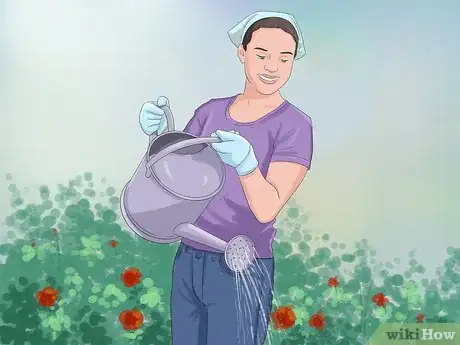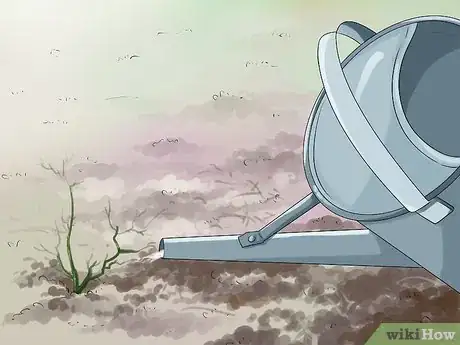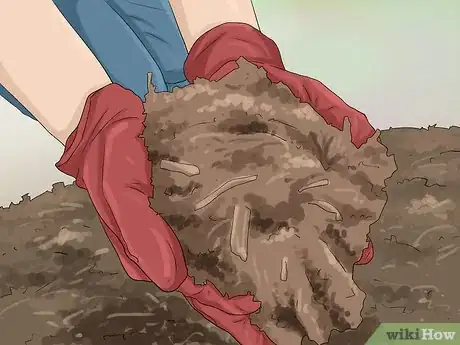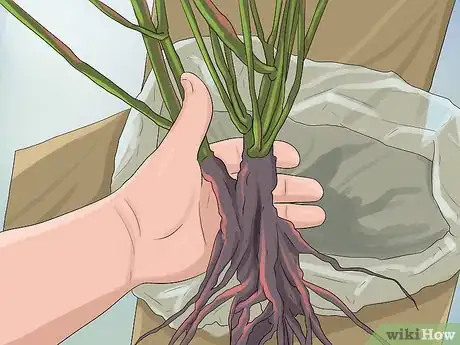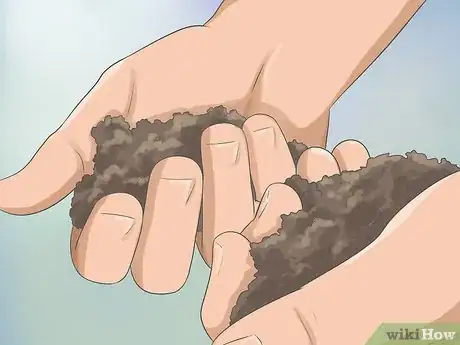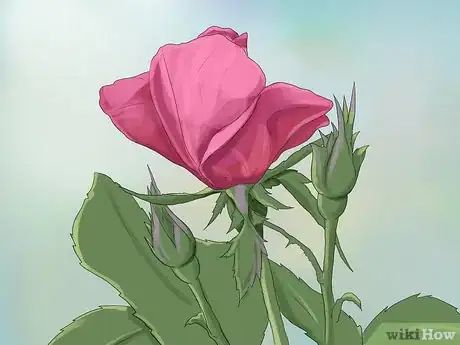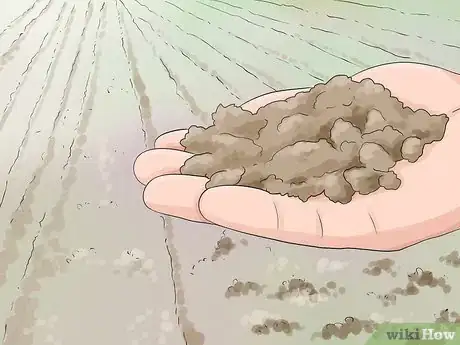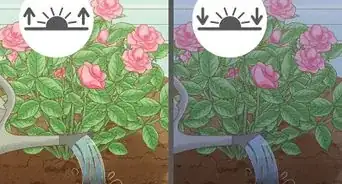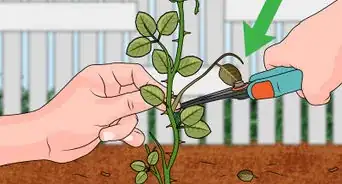This article was co-authored by Andi Xoch. Andi Xoch is a Plant Specialist and the Owner of Latinx with Plants, a plant shop and resource based in Los Angeles, California. With over a decade of experience in the plant and garden industry, she specializes in plant maintenance, growth, and education. Andi has grown her business from a pop-up shop at home to two brick-and-mortar plant shops. She aims to share how to use plants as a healing tool.
There are 10 references cited in this article, which can be found at the bottom of the page.
wikiHow marks an article as reader-approved once it receives enough positive feedback. In this case, 92% of readers who voted found the article helpful, earning it our reader-approved status.
This article has been viewed 219,172 times.
Your roses need water to grow and continue putting out beautiful flowers, but too much water can actually do more harm than good. Whether you're new to caring for and watering roses or just wanting to troubleshoot an old rose bush that isn't thriving anymore, don't worry. Properly watering roses is easy once you know what to do. Check out the tips below to learn how often you should water your roses and how much water you should be giving them to help them flourish.
Things You Should Know
- Water the soil to the depth of 18 inches (45.7 cm). Water around once per week.
- If your roses start to look droopy or wilted, give them water right away. In the future, fight off dryness by applying a thick layer of mulch around the flowers.
- Wind and dry heat can cause roses to dry out faster. On extremely hot summer days, expect to water your roses each day.
Steps
Using the Correct Watering Techniques
-
1Give the rose bushes a lot of water, less frequently. It’s better to give the rose bushes a large amount of water less often than a small amount of water more often. For example: giving a full watering can of water once a week rather than a quarter can every other day.
- This is because it’s better for the plant to develop deep roots in quest of water and it’s also better if the soil isn’t permanently waterlogged.
- This is an important consideration, especially on clay soils or other poor-draining soils where waterlogging is more likely.
-
2Use the right kind of watering can. Take a large watering can - if possible, it’s best to use a watering can ‘rose’, which is the showerhead-style spout that stops the water coming out in a single stream.
- If you use a single spout can it can erode the soil around the roots. Exposure will eventually damage the roots. Roses will always prefer rainwater but this isn’t essential.
- If you are using a garden hose, avoid a high-pressure jet as this can also erode the soil from the roots. Alternatively, you could set up an irrigation system - but be careful to monitor it to make sure it is watering the roses the right amount and is working properly.
Advertisement -
3Water the soil to a depth of 18 inches (45.7 cm).[1] Water the ground at the base of the plant fairly slowly, pausing for it to soak in. Your aim is to wet the soil to a depth of about 18 inches (45.7 cm). After very dry spells the earth can bake hard and it can take longer for it to absorb water. Be patient!
-
4Water your roses first thing in the morning.[2] It’s usually best to avoid watering your rose bushes during the heat of the day. Try to get in the habit of watering them first thing in the morning before the sun gets too high.
- This lets foliage dry off by the time the cooler evening air gets to them. If a rose has wet foliage it can be more at risk of mildew and blackspot. This isn’t a problem if you are using an irrigation system placed on the soil surface as the foliage won’t be getting wet.
- Even if you have an irrigation system in place, some gardeners recommend occasional watering from above using a hose or can, in order to dislodge any spider mites before they become a problem.
-
5Apply a thick layer of mulch to keep moisture in the soil. A thick layer of mulch applied around roses will really help to keep the moisture in the soil and reduce the need for watering as often.[3]
- Well-rotted horse manure works well for roses – apply after feeding them, ideally in late spring, and on damp earth. Apply a 3 inch (7.6 cm) depth around the rose when the ground isn’t cold or frozen.
- Every year, remove the spent mulch and replace it with a fresh layer. The start of the growing season (spring) is a good time to feed your roses and replace the mulch.
-
6Reduce watering by incorporating a water-retaining material into the soil. You can also help to reduce watering by incorporating a water-retaining material at planting time. These are available from garden stores and are designed to be mixed in with the soil or compost when planting.
- Additionally, some varieties of rose are more drought-tolerant, or will even tolerate shade, so consider choosing one of these varieties to reduce water requirements.
-
7Know that container-grown roses require more water. Container grown roses tend to dry out a bit faster than ground planted ones, so these will need watering more. In hot conditions, be prepared to water container-grown roses every day.
- You can help reduce water requirements by mulching. Inorganic mulches such as pebbles or gravel can work well in containers and look attractive.
- Also consider using a watering device such as a spike designed to water potted plants gradually over time. These can be purchased from garden stores, or make your own using an old plastic bottle using an online tutorial.
-
8Water your roses immediately if they start to look droopy. If your roses start to wilt and get droopy, they probably need watering.[4]
- Over the long term the leaves will dry up and wither and the flowers will bloom less and possibly even die. [5]
- Smaller blooms and less of them is a sign a rose is stressed, probably due to lack of water.
-
9Don't overwater roses, as this causes root rot. Overwatering can cause root rot, especially in poor-draining soils. Signs to watch out for include yellow leaves and leaf drop, and new shoots wilting and dying away.[6]
- Take care that container-planted roses never sit in water. Avoid putting containers in trays, bowls, or saucers.
- Too much water can also make the foliage chlorotic (yellowish and mottled).[7]
Identifying Your Roses' Needs
-
1Identify the type of soil in your garden.[8] Soil type and drainage will influence how often you need to water your roses. Sandy soil will drain easily and won’t retain water very well. If your garden has clay-type soil then it will retain moisture better. However, if the soil is extremely clay-heavy, you’ll need to add some compost or similar horticultural material to improve it at planting time.
-
2Consider the yearly weather conditions. Obviously plants need watering during hot, dry weather. But you should also be aware that wind can dry out plants a great deal, even in cold weather. Newly planted roses may be at risk of drought during a dry, windy fall or winter.[9]
- As a rough guide, in extremely hot weather you should assume rose plants will need watering daily.[10] On a standard summer day with decent heat, you will need to water every two or three days, and in warm dry weather you will only need to water about once a week.
- Also consider how windy it is when deciding how much to water your plants: windy weather means more water is required.
-
3Think about the age of your roses. Recently-planted roses still haven’t developed their root structure, so if you’ve planted in the last few months it is especially important to water the roses regularly during dry spells – even if you planted just before winter. Lack of water is the most common reason newly planted plants fail.
- Once established, plants will be more adept at seeking water from a wider area of soil, so you can start to ease off your watering regime after six months.
-
4Pay attention to the size of your rose bush. Larger rose bushes will have roots spread over a wider area of soil than smaller ones. This means larger rose bushes will require more water to ensure the water reaches all of their roots.
-
5Determine how dry the soil is.[11] [12] Another way to assess if roses need watering is to dig a few inches into the soil next to the plant, taking care not to damage the roots. If the soil is dry under the surface, then you need to water the rose now. If only the surface is dry, you can wait a bit longer before watering.
Community Q&A
-
QuestionIs it bad if water hits roses from above?
 Community AnswerSometimes too much water from above can weigh the roses down; however, most of the water will still reach the roots of the plant.
Community AnswerSometimes too much water from above can weigh the roses down; however, most of the water will still reach the roots of the plant. -
QuestionI am using a crushed banana and coffee grounds to fertilize my plants. How often should this be done?
 Community AnswerI would suggest doing this once a month to start, and then alter the schedule as needed depending on the results.
Community AnswerI would suggest doing this once a month to start, and then alter the schedule as needed depending on the results. -
QuestionHow long should I leave a soaker hose going on my roses for once-a-week watering?
 Community AnswerI find that a good minute or two of watering works best. Just enough water to get the plants nice and misty along with getting the soil moist. It's also a good idea to water them at night so that the sun doesn't dry up all the water on the plant; it will end up damaging the plant if it does.
Community AnswerI find that a good minute or two of watering works best. Just enough water to get the plants nice and misty along with getting the soil moist. It's also a good idea to water them at night so that the sun doesn't dry up all the water on the plant; it will end up damaging the plant if it does.
References
- ↑ https://www.bhg.com/gardening/flowers/roses/watering-roses/
- ↑ https://youtu.be/wkmKaLrOBJ8?t=29
- ↑ https://scvrs.homestead.com/WaterRightAmount.html
- ↑ Andi Xoch. Plant Specialist. Expert Interview. 4 August 2021.
- ↑ Andi Xoch. Plant Specialist. Expert Interview. 4 August 2021.
- ↑ Andi Xoch. Plant Specialist. Expert Interview. 4 August 2021.
- ↑ Andi Xoch. Plant Specialist. Expert Interview. 4 August 2021.
- ↑ https://www.dummies.com/home-garden/gardening/urban-farming-how-to-determine-your-soil-type/
- ↑ https://www.miraclegro.com/en-ca/library/container-gardening/how-care-roses
- ↑ https://www.rose.org/single-post/2018/04/19/How-Often-Should-I-Water-My-Roses
- ↑ Andi Xoch. Plant Specialist. Expert Interview. 4 August 2021.
- ↑ https://www.dummies.com/home-garden/gardening/flower-gardening/how-to-water-roses/
- http://www.harlequinsgardens.com/plants/roses/planting-instructions-for-roses/
- https://www.gardendesign.com/roses/care.html
About This Article
To properly water your roses, give them a full watering can of water once or twice a week. Try to water your plants in the morning so the leaves have time to dry off during the day. If the leaves are wet at night, they might develop mildew. If your roses appear droopy or are wilting, water them right away, since this is a sign they’re drying out. You can also add a layer of mulch to the soil to help it retain water. On the other hand, cut back on watering if you notice yellow leaves or new shoots wilting, which are signs that your roses have been watered too much. For tips on how to water newly-planted rose bushes, keep reading!
